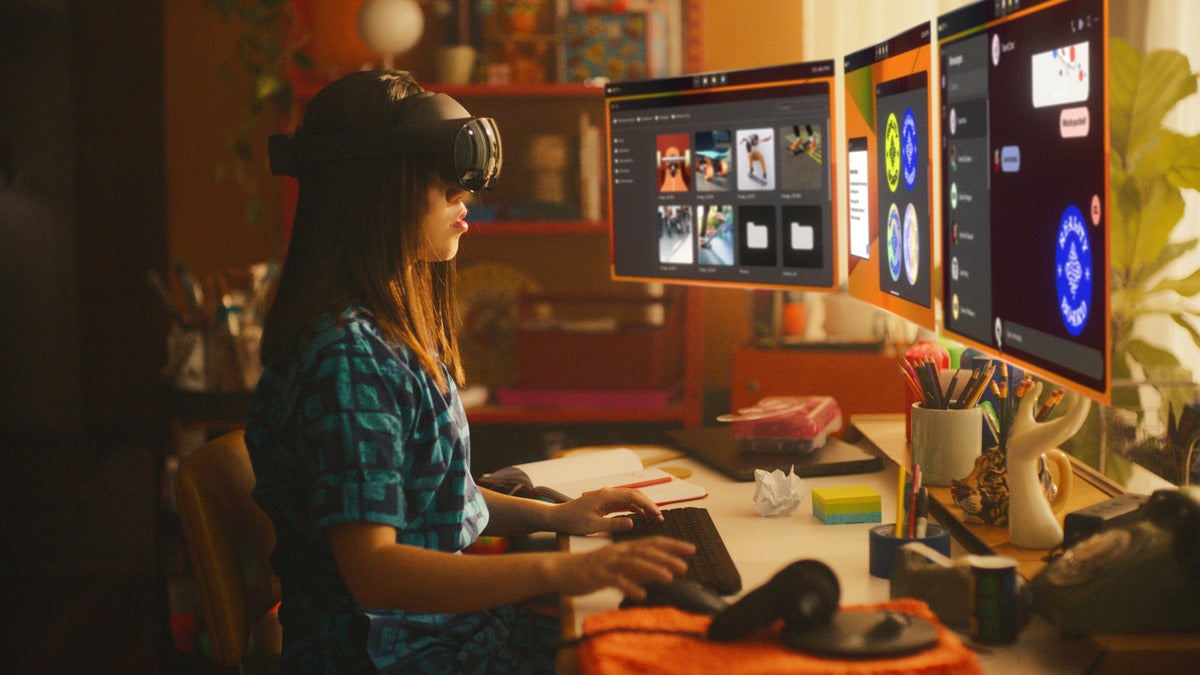Microsoft’s office productivity apps can now be accessed on Meta’s Quest headsets, offering access to Word, Excel and PowerPoint in mixed and virtual reality spaces. Though office workers are unlikely to swap laptops for mixed-reality devices until the hardware improves, analysts see potential being able to access productivity tools on multiple virtual screens.
At Meta Connect in 2022, Meta CEO Mark Zuckerberg and Microsoft CEO Satya Nadella announced plans to bring Office apps and Windows 365 cloud desktops to Quest devices. After more than a year in a development, Word, Excel, PowerPoint became generally available last week on Quest, Quest 2, Quest and Quest Pro headsets, as noted by Android Central. These are web versions of the three apps hosted in the cloud, rather than native apps with any virtual or mixed reality-specific features. Once logged into a Microsoft account, users can interact with the apps either via hand-tracking gestures, or, more suitable for productivity tasks, a Bluetooth-connected keyboard and mouse.
The apps can be viewed on up to three virtual screens in virtual or mixed reality mode.
It’s likely to be a while before workers use mixed-reality headsets to get work done. In his initial tests of the applications on Meta’s Quest 3 headset, Avi Greengart, founder and lead analyst at Techsponential, said the device resolution and mixed-reality passthrough “aren’t good enough to want to spend too much time using Office apps in the headset.” He described the handheld controllers that manage the user interface as “clunky,” though he noted the potential for practicing PowerPoint speeches: “Microsoft simply needs to add a teleprompter mode,” he said.
However, Greengart also predicted that mixed reality will be a better fit for productivity as the hardware continues to improve. The upcoming launch of Apple’s Vision Pro has helped reignited interest in the potential of so-called “spatial computing,” with workplace productivity use cases touted alongside entertainment use cases.
“As we get spatial computing devices with higher resolution and even better passthrough capabilities, working in VR opens up new potential productivity gains – either as a multi-monitor setup or with unique software capabilities designed for the mixed [reality] environment,” said Greengart.
Quest devices are predominantly aimed at gaming and entertainment, but Meta has also targeted workplace productivity in terms of applications, such as Horizon Workrooms, and hardware, with the launch of the Quest Pro a year ago. Meta alsorecently introduced a device and app management platform, Quest for Business, to simplify deployments of headsets to employees. Quest device owners will be able to access Microsoft’s Mesh “immersive spaces” in its Teams app when the feature becomes generally available in January.
The most common business use cases for virtual or mixed reality centers around education and training simulations, as well as industry-specific applications. “It is still early days for Office productivity tools on mixed reality devices,” said said Raúl Castañón, senior research analyst at 451 Research, a part of S&P Global Market Intelligence. “Currently deployed use cases tend to be industry- or use case-specific and will require specialized applications.”
However, he pointed to a recent survey of 1,000 IT and OT decision-makers (S&P Global’s 2023 Worldwide Metaverse Enterprise Survey), which indicated thathorizontal productivity tools are “next in line,” after employee training applications.
“Office productivity tools — namely, the word processor and spreadsheet — are evolving into cloud-based, real-time collaborative tools; bringing these tools to mixed reality devices such as Quest 3/Quest Pro is a logical next step,” said Castañón. “However, Microsoft still has work to do. In addition to optimizing the user experience for mixed reality devices, this will require expanding the scope to include Teams.”
According to the S&P survey, nearly half of respondents (48%) expect existing enterprise collaboration and communication tools such as Microsoft Teams and Zoom to be “further enhanced with metaverse capabilities,” he said.
Copyright © 2023 IDG Communications, Inc.
This story originally appeared on Computerworld

